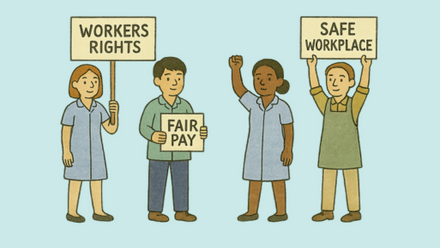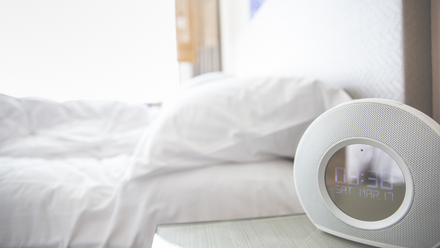Homecare data: An explainer
The difference in numbers
Each month, the Department of Health and Social Care (DHSC) publishes experimental statistics on adult social care in England. These contain data relevant to the homecare sector – for example, on COVID-19 vaccination rates, absences due to COVID-19 and PPE availability. According to their methodology, this is “taken from management information submitted by care providers… to …Capacity Tracker.”
Amongst these statistics, DHSC also releases information on staffing levels. This comes from a Capacity Tracker question, asking providers for the number of staff in their organisation who have face-to-face contact with those they support.
Similarly, Skills for Care publish staffing figures for homecare in their annual ‘The state of the adult social care sector and workforce in England’ (and in particular, their ‘Summary of domiciliary care services’ factsheet), typically released each October. For 2020/21, they estimated that there were 590,000 jobs (i.e. filled posts) in homecare. Their figures are based on completion of the Adult Social Care Workforce Data Set (ASC-WDS).
However, according to DHSC’s most recent statistics, the number of homecare staff was only 405,321 for the week ending 25 January 2022.
The following table outlines why there is such a difference between these two figures:
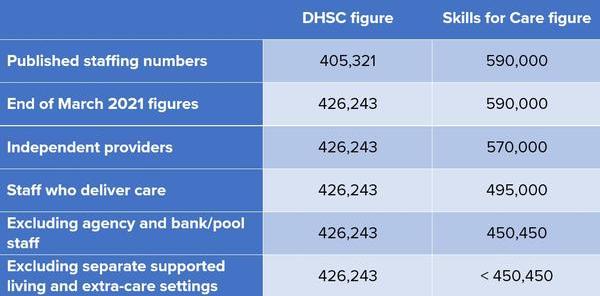
As way of explanation, please note the following points:
- Skills for Care state that ‘independent sector information is derived from the ASC-WDS as at March 2021’. Therefore, the table presents the DHSC figure at the end of this month.
- DHSC’s figure relates to the independent (and CQC-registered) homecare sector. Skills for Care’s estimate of 590,000 includes those in the statutory sector.
- As mentioned above, Capacity Tracker only asks for staff who deliver care. Under the ‘Employment overview’ tab of their data visualisation, Skills for Care estimate the number of direct care staff for the CQC-registered, independent non-residential sector. However, DHSC opine that these two factors may not correspond exactly.
- DHSC’s figures exclude agency and bank/pool staff. In their data visualisation, Skills for Care state that, in the CQC-registered, independent non-residential sector, 9% of direct care staff are either agency or bank/pool.
- In conversation with Capacity Tracker representatives, the number working in separate supported living and extra-care settings was thought to be in the low tens of thousands. This is included by Skills for Care, but not by DHSC.
- Skills for Care point out that the ASC-WDS is a ‘non-mandatory return for the independent sector’. For 2020/21, the ASC-WDS held data for 46% of all CQC-regulated independent locations (including homecare). The Skills for Care data is also subject to suppression and rounding.
- DHSC’s figures relate to the proportion of providers who have reported in Capacity Tracker (see below).
Levels of unvaccinated staff
The Homecare Association’s position on vaccination as a condition of deployment (VCOD) has already been made abundantly clear – for example, please see a blog by our CEO, Dr Jane Townson, on the ‘risks of ridiculous regulations’. Consequently, though strongly supporting vaccination against COVID-19, we have welcomed the Government’s announcement of a consultation to scrap this requirement.
Using DHSC’s figures, we can analyse the number of homecare staff providing direct care, both overall and those who are not double (i.e fully) vaccinated.
Reported figures
Firstly, we consider only providers that have reported at least once in Capacity Tracker.
Since the end of June 2021 (shortly after it was announced that VCOD would be introduced in care homes) up until the week ending 25 January 2022 (most recent data point), the number of careworkers who were not fully vaccinated had decreased by 58% (if the number of workers had remained constant, the unvaccinated proportion would have dropped by 56%). As it stands, close to 71,750 are reported on Capacity Tracker as not to be double jabbed.
However, over this timeframe, the number of staff had also fallen by 5%. Indeed, since the week when the consultation was launched on extending VCOD to other care settings, almost 18,000 frontline homecare workers have left their employment.
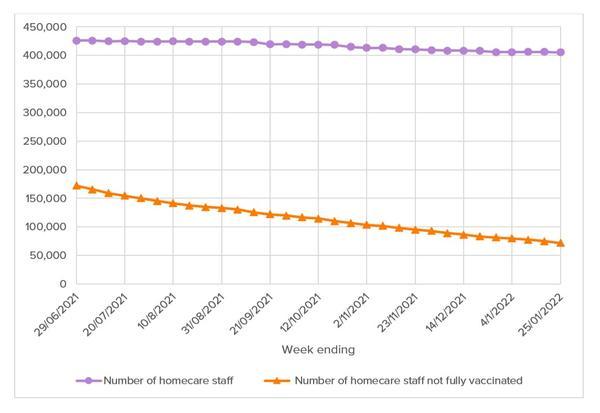
We can also break this data down by region. Concentrating on the most recent timepoint (week ending 25 January 2022), 44% of the workforce providing direct care are based in either the North West, South East or London.
However, London is a clear outlier in the English regions for the percentage of staff who remain not fully vaccinated (28%), amounting to around 16,420 careworkers. It is unsurprising, therefore, that London is also the region with the largest current absence rate due to COVID-19 (4.5%).
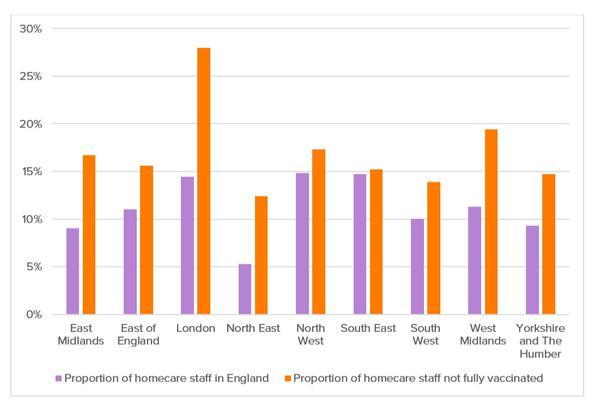
Indeed, the proportion of staff not double jabbed in London has consistently lagged behind the corresponding national figure (which currently stands at 18%). While the gap has closed since the end of June, it is still notable.
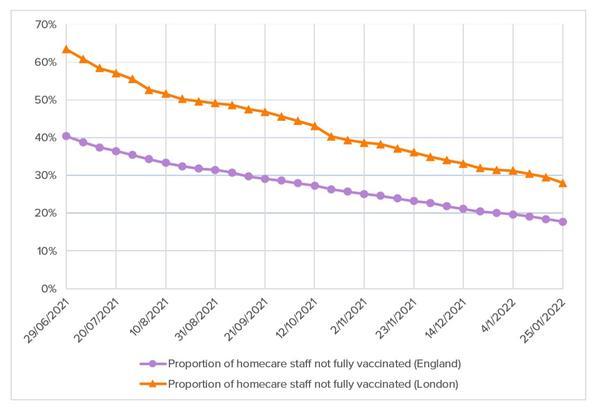
Adjusted figures
Secondly, we now use adjusted figures to replicate our national analysis above – this is to include both providers who have reported at least once in Capacity Tracker and those who have never reported (i.e. all homecare providers). This means adjusting the staffing levels and recalculating the unvaccinated figures.
One way to do this is to adjust by reported response rate – in this case, for the take-up of a second Covid vaccine dose. This is logical given our focus on VCOD, but it should be stressed that the adjusted numbers would be different if we considered reporting for the first jab instead. And as elucidated by the Nuffield Trust in their analysis of social care worker figures, this assumes similar staffing levels between providers who have and have not reported, and given the uncertainty involved, the following can only be considered to be estimates.
The following chart compares the homecare staffing levels using adjusted and unadjusted figures (which we saw earlier). As it stands, there are just over 433,000 (adjusted) homecare workers – a statistic that is 7% higher than the number for those reporting. Furthermore, it seems that there has been a steeper decline in staff among all providers – since the end of June 2021, the drop was 13%, with up to 39,650 workers leaving their employment following the launch of the wider VCOD consultation (more than double the reported figure).
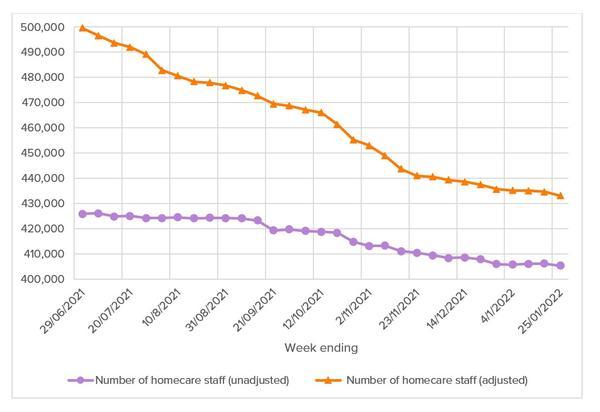
Consequently, approximately 76,650 staff from all homecare providers are currently not fully vaccinated. Since the end of June 2021, there has been a 62% reduction in the number of staff overall who were unvaccinated (or 56% if the adjusted staff figures had remained constant).
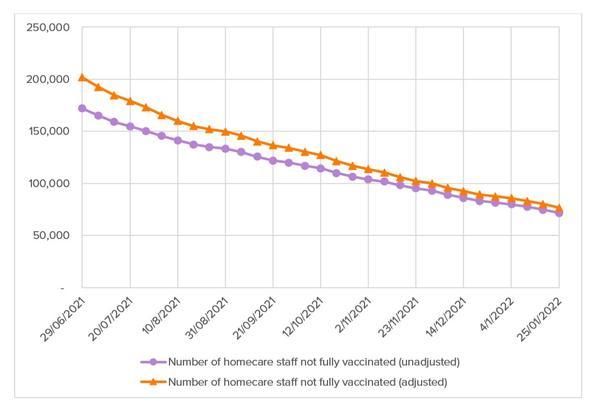
When considering how many staff would not be double jabbed by 1 April 2022, we must add on agency and bank/pool staff and those in separate supported living and extra care settings.
Yet, in their impact statement on extending VCOD more widely, the Government concluded that 10,000 staff in homecare and other social care settings were expected to be exempt from vaccination.
Thus, the number of homecare workers who may have been required to leave their employment on 1 April 2022 due to VCOD could have been up to 70,000 (based on the current trend of approximate figures for unvaccinated staff).
This would have been an unconscionable outcome for the sector, and so it is a relief that the Government has decided to change its approach.



